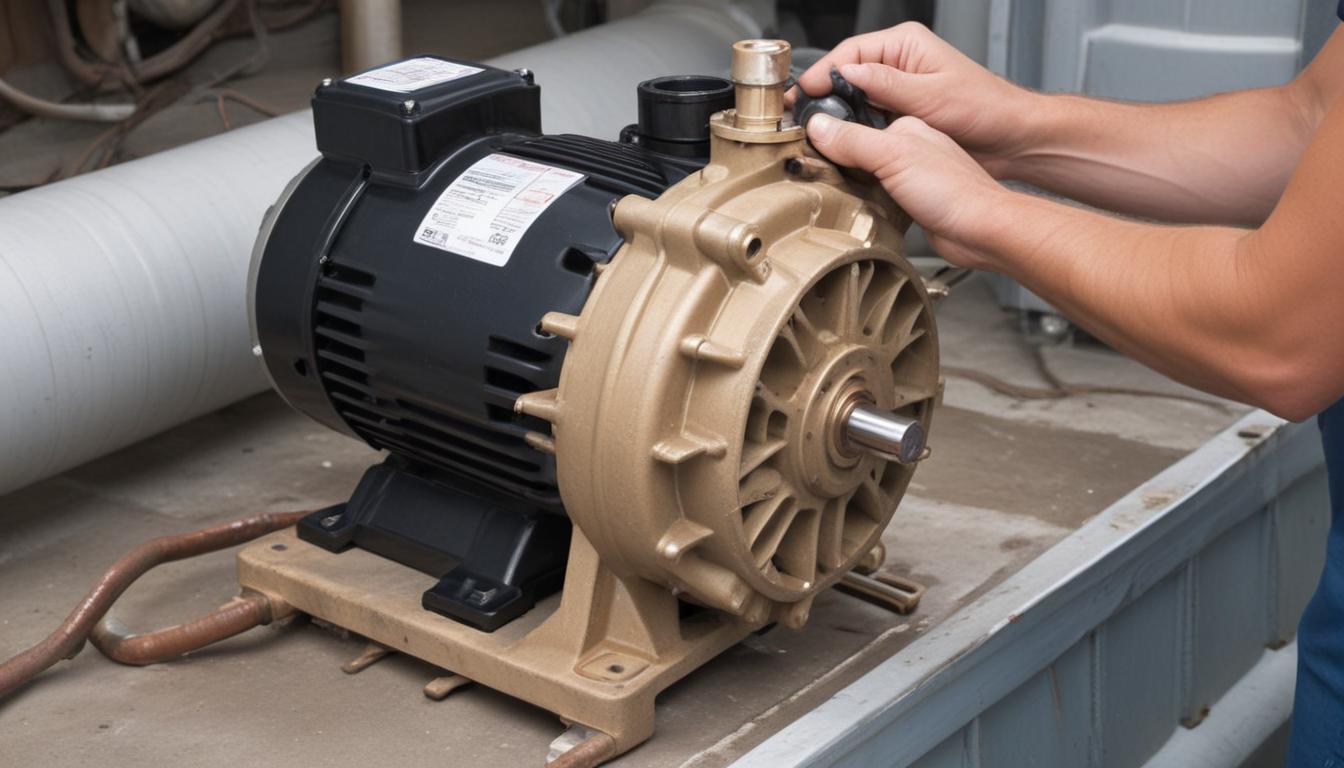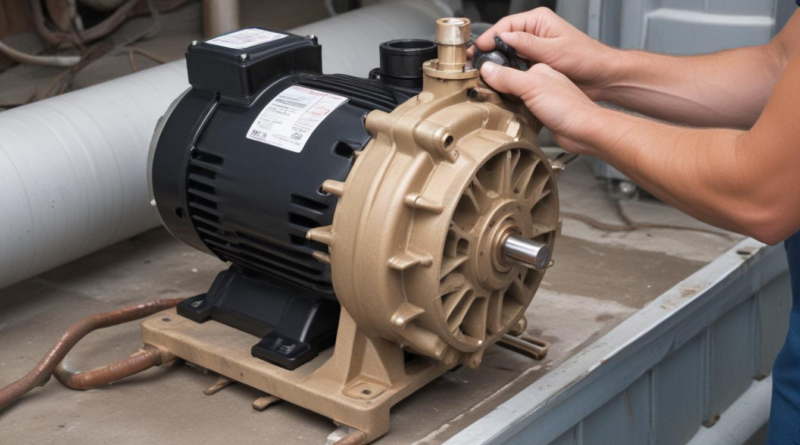how to troubleshoot pump motor issues
When addressing pump motor issues, it is essential to begin by thoroughly examining the power supply to ensure the motor receives consistent and adequate power. Start by verifying that the electrical outlet or power source is functioning correctly.
- Voltage Verification: Utilize a multimeter to check that the voltage supplied matches the motor’s specifications, typically indicated on the motor’s nameplate.
- Power Stability: Ensure there are no fluctuations or interruptions in the power source that could lead to motor malfunctions.
- Phase Balance: For three-phase motors, confirm that all phases are present and balanced to prevent uneven motor operation.
- Circuit Protection: Inspect and reset any tripped circuit breakers or replace blown fuses that may be disrupting power to the motor.
- External Control Devices: Check the functionality of switches, relays, and contactors that control power flow to the motor.
Additionally, consider the following table to systematically document your findings and assist in the troubleshooting process:
| Inspection Step | Details |
|---|---|
| 1. Verify Voltage Levels | Use a multimeter to ensure voltage matches motor requirements. |
| 2. Check Power Stability | Monitor for consistent power delivery without fluctuations. |
| 3. Inspect Circuit Breakers | Reset tripped breakers or replace blown fuses as necessary. |
| 4. Confirm Phase Balance | Ensure all phases are present and evenly balanced in three-phase systems. |
| 5. Test Control Devices | Verify the operation of switches, relays, and contactors controlling the motor. |
By systematically inspecting the power supply, you can identify potential issues early and implement effective solutions to maintain optimal motor performance.
check for loose connections
Ensuring all electrical connections are secure is crucial when addressing pump motor issues. Loose connections can lead to intermittent power supply, increased resistance, and eventual motor failure. Begin by de-energizing the system to ensure safety before inspecting any connections.
- Visual Inspection: Examine all wiring and terminal connections for signs of wear, corrosion, or damage. Look for darkened wires or melted insulation, which indicate overheating.
- Tighten Connections: Use appropriate tools to ensure that all terminals are firmly tightened. Pay special attention to connections at the motor, control panel, and power source.
- Check for Corrosion: Inspect connectors and terminals for any signs of corrosion or oxidation. Clean or replace affected components to restore proper conductivity.
- Secure Cables: Ensure that all cables are properly secured and not subjected to undue stress or movement, which can loosen connections over time.
- Inspect Insulation: Verify that all wire insulation is intact to prevent short circuits. Replace any damaged insulation immediately.
To facilitate a comprehensive troubleshooting process, utilize the following table to track and address any loose connection issues:
| Inspection Step | Details |
|---|---|
| 1. De-energize System | Ensure all power sources are turned off before inspection. |
| 2. Conduct Visual Inspection | Look for signs of wear, corrosion, or damage on all connections. |
| 3. Tighten Terminals | Use the appropriate tools to secure all electrical terminals firmly. |
| 4. Clean Corroded Connections | Remove any corrosion using suitable cleaning agents or replace affected parts. |
| 5. Verify Cable Security | Ensure all cables are properly supported and not prone to movement. |
| 6. Inspect Wire Insulation | Check for and repair any damaged insulation to prevent short circuits. |
Addressing loose connections promptly can prevent further pump motor issues and enhance the overall reliability of the system. Implementing these solutions as part of your regular maintenance routine will contribute to the longevity and efficient operation of your pump motor.
evaluate motor components
Evaluating the internal parts of the motor is a critical step in identifying and resolving pump motor issues. A thorough assessment of motor components can reveal wear, damage, or malfunction that may impede performance. Begin by disconnecting the motor from the power source to ensure safety before proceeding with the evaluation.
- Inspect Bearings: Check for signs of wear, grinding noises, or excessive play in the bearings. Worn bearings can lead to increased friction and overheating.
- Examine the Rotor and Stator: Look for any physical damage, such as cracks or burn marks, on both the rotor and stator. Ensure that there is no misalignment or imbalance that could affect motor operation.
- Check Windings: Assess the condition of the motor windings for signs of insulation breakdown, corrosion, or overheating. Use a multimeter to measure the resistance and ensure it aligns with manufacturer specifications.
- Assess Cooling Systems: Verify that cooling fans or other cooling mechanisms are functioning correctly. Overheating due to inadequate cooling can cause significant motor damage.
- Inspect the Shaft: Ensure the motor shaft is straight and free from bends or distortions. A damaged shaft can lead to improper alignment with the pump and reduce overall efficiency.
- Evaluate the Lubrication: Confirm that all moving parts are adequately lubricated. Insufficient lubrication can cause increased wear and tear, leading to motor failure.
Utilize the following table to systematically document the condition of each motor component and identify areas that require attention during the troubleshooting process:
| Component | Inspection Details | Condition | Recommended Action |
|---|---|---|---|
| Bearings | Listen for unusual noises and check for play | Good/Worn | Replace if worn |
| Rotor and Stator | Inspect for physical damage and alignment | Intact/Misaligned | Realign or repair as needed |
| Windings | Measure resistance and look for insulation issues | Within Specs/Compromised | Repair or replace windings |
| Cooling Systems | Ensure fans are operational and not blocked | Functional/Non-functional | Repair or clean cooling components |
| Shaft | Check for straightness and absence of bends | Straight/Bent | Replace shaft if bent |
| Lubrication | Verify adequate lubrication of moving parts | Sufficient/Insufficient | Add or replace lubricant |
By meticulously evaluating each motor component, you can pinpoint specific issues and apply targeted solutions to restore optimal functionality. Regular maintenance and component assessments are essential practices to prevent future pump motor issues and ensure the longevity of the motor system.
test electrical circuits
 Ensuring that the electrical circuits associated with the pump motor issues are functioning correctly is vital in diagnosing problems effectively. Faulty circuits can lead to inadequate power delivery, intermittent operation, or complete motor failure. The following steps outline how to thoroughly test electrical circuits as part of your troubleshooting process.
Ensuring that the electrical circuits associated with the pump motor issues are functioning correctly is vital in diagnosing problems effectively. Faulty circuits can lead to inadequate power delivery, intermittent operation, or complete motor failure. The following steps outline how to thoroughly test electrical circuits as part of your troubleshooting process.
- Continuity Testing: Use a multimeter to verify that there is a continuous path for electrical current in each circuit. This helps identify any breaks or open circuits that could interrupt power flow.
- Resistance Measurements: Measure the resistance across various components, such as windings and connections, to detect any abnormal values that may indicate damaged components or poor connections.
- Insulation Resistance Testing: Utilize an insulation resistance tester (megger) to assess the integrity of the motor’s insulation. Low insulation resistance can lead to short circuits and motor failure.
- Check for Short Circuits: Inspect the wiring for any signs of short circuits, such as burnt insulation or discolored wires, which can compromise circuit functionality and safety.
- Examine Grounding: Ensure that all grounding connections are secure and free from corrosion. Proper grounding is essential for safe motor operation and to prevent electrical hazards.
- Component Testing: Individually test components like relays, contactors, and switches to confirm they are operating within specified parameters.
To facilitate organized troubleshooting, record your findings using the table below:
| Inspection Step | Details |
|---|---|
| 1. Continuity Test | Verify continuity in all motor and control circuits using a multimeter. |
| 2. Resistance Measurement | Measure resistance across windings and hardware to identify anomalies. |
| 3. Insulation Resistance | Perform megger tests to ensure insulation integrity meets standards. |
| 4. Short Circuit Inspection | Look for burnt or damaged wiring that indicates a short circuit. |
| 5. Grounding Verification | Check all grounding points for secure and clean connections. |
| 6. Component Operation | Test relays, contactors, and switches for proper functionality. |
By meticulously testing the electrical circuits, you can uncover hidden issues that may not be immediately apparent, ensuring comprehensive solutions to maintain the reliability and efficiency of your pump motor system.
assess control systems
Assessing the control systems is a pivotal aspect of addressing pump motor issues. Control systems manage the operation of the pump motor, and any malfunction within these systems can lead to inconsistent performance or complete failure. A comprehensive evaluation of the control mechanisms ensures that the pump operates smoothly and reliably. Begin by verifying that all control components are receiving the appropriate signals and functioning as intended.
- Inspect Control Panels: Examine the control panels for any visible signs of damage, such as burnt components or loose wiring. Ensure that indicators and displays are functioning correctly to provide accurate information about the motor’s status.
- Verify Sensor Functionality: Check all sensors connected to the control system, including pressure, temperature, and flow sensors. Ensure that they are calibrated correctly and providing accurate readings to prevent erroneous control actions.
- Evaluate Programmable Logic Controllers (PLCs): If the system utilizes PLCs, verify that the programming is correct and that there are no errors or malfunctions in the controller’s operation. Update or reprogram the PLC if necessary to address any identified issues.
- Check Control Wiring: Inspect all wiring within the control system for signs of wear, corrosion, or damage. Replace any compromised wires to maintain reliable communication between control components.
- Test Relay and Contactor Operations: Ensure that relays and contactors are operating within their specified parameters. Faulty relays or contactors can disrupt the control signals, leading to improper motor operation.
- Assess User Interfaces: Verify that all user interfaces, such as switches, buttons, and touchscreens, are responsive and functioning correctly. Malfunctioning interfaces can impede effective control and monitoring of the pump motor.
- Review Control Logic: Analyze the control logic to ensure that it aligns with the desired operational parameters. Incorrect control logic can result in inefficient motor operation or trigger unnecessary shutdowns.
To systematically assess the control systems, utilize the following table to document your findings and identify necessary interventions:
| Inspection Step | Details | Status | Recommended Action |
|---|---|---|---|
| 1. Control Panel Inspection | Check for physical damage and verify indicator functionality. | Normal/Issues Found | Repair or replace damaged components as needed. |
| 2. Sensor Verification | Ensure all sensors are calibrated and reporting accurately. | Calibrated/Out of Range | Calibrate or replace faulty sensors. |
| 3. PLC Evaluation | Review PLC programming and operation for errors. | Functional/Error Detected | Update or reprogram PLC to correct issues. |
| 4. Control Wiring Check | Inspect wiring for wear, corrosion, or damage. | Intact/Damaged | Replace compromised wires to ensure reliability. |
| 5. Relay and Contactor Testing | Verify operational parameters of relays and contactors. | Operational/Non-operational | Repair or replace faulty relays/contactors. |
| 6. User Interface Assessment | Check responsiveness and functionality of control interfaces. | Responsive/Unresponsive | Fix or replace malfunctioning user interface components. |
| 7. Control Logic Review | Analyze control logic for alignment with operational parameters. | Correct/Incorrect | Modify control logic to match desired operations. |
By meticulously assessing each component of the control systems, you can identify and address specific pump motor issues. Implementing these solutions ensures that the control mechanisms operate seamlessly, thereby enhancing the overall efficiency and reliability of the pump motor system.


